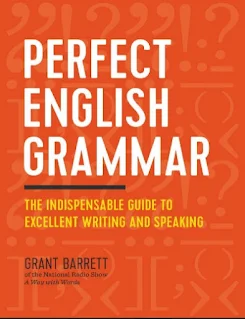 |
| Perfect English Grammar by Grant Barrett |
Parts of Speech:
Parts
of speech are the basic categories of words in a language. They help us
understand the function of a word in a sentence. Here are the main parts of
speech:
Noun:
Definition:
A word that represents a person, place, thing, or idea.
Example:
cat, city, happiness.
Pronoun:
Definition:
A word that takes the place of a noun.
Example:
he, she, it, they.
Verb:
Definition:
A word that describes an action or state of being.
Example:
run, think, is.
Adjective:
Definition:
A word that describes or modifies a noun or pronoun.
Example:
red, tall, beautiful.
Adverb:
Definition:
A word that describes or modifies a verb, adjective, or another adverb.
Example:
quickly, very, well.
Preposition:
Definition:
A word that shows the relationship between a noun (or pronoun) and another word
in the sentence.
Example:
in, on, under.
Conjunction:
Definition:
A word that connects words, phrases, or clauses.
Example:
and, but, or.
Interjection:
Definition:
A word or phrase used to express strong emotion or surprise.
Example:
wow, oh, oops.
Sentence structure:
Sentence structure refers to the way words are organized to form a complete and grammatically correct sentence. It involves understanding how different elements of a sentence fit together to convey meaning. The key components of sentence structure include:
Subject:
The
subject is the main noun or pronoun that the sentence is about. It typically
performs the action in the sentence.
Example:
The cat sat on the windowsill.
Predicate:
The
predicate contains the verb and all the information about what the subject is
doing. It includes the verb and may also have other elements like objects or
complements.
Example:
The cat sat on the windowsill.
Verb:
The
verb is a word that expresses an action, occurrence, or state of being.
Example:
The cat sat on the windowsill.
Object:
The
object is a noun or pronoun that receives the action of the verb. There can be
a direct object and an indirect object.
Example:
The cat sat on the windowsill.
Complement:
A
complement is a word or group of words that completes the meaning of a verb. It
can be a direct object, indirect object, or subject complement.
Example:
The cat is happy.
Modifiers:
Modifiers
are words or phrases that provide additional information about other elements
in the sentence. They can be adjectives or adverbs.
Example:
The cat, with a fluffy tail, sat on the windowsill.
Clauses:
A
clause is a group of words containing a subject and a predicate. There are two
types of clauses: independent (can stand alone as a complete sentence) and
dependent (cannot stand alone).
Example:
When the cat sat on the windowsill, it looked outside.
Phrase:
A
phrase is a group of words that function as a single unit within a sentence. It
lacks a subject and a verb.
Example:
On the windowsill, the cat sat.
Understanding
how these elements work together helps in constructing sentences that are
clear, coherent, and grammatically correct. Different sentence structures can
convey various meanings and emphasize different parts of the information being
communicated.
